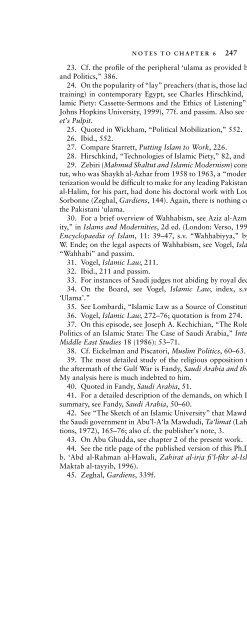Download (1 MB) - Islam and Christian-Muslim Relations: Articles ...
Download (1 MB) - Islam and Christian-Muslim Relations: Articles ...
Download (1 MB) - Islam and Christian-Muslim Relations: Articles ...
You also want an ePaper? Increase the reach of your titles
YUMPU automatically turns print PDFs into web optimized ePapers that Google loves.
NOTES TO CHAPTER 6 24723. Cf. the profile of the peripheral ‘ulama as provided by Zeghal: “Religion<strong>and</strong> Politics,” 386.24. On the popularity of “lay” preachers (that is, those lacking formal religioustraining) in contemporary Egypt, see Charles Hirschkind, “Technologies of <strong>Islam</strong>icPiety: Cassette-Sermons <strong>and</strong> the Ethics of Listening” (Ph.D. dissertation,Johns Hopkins University, 1999), 77f. <strong>and</strong> passim. Also see Gaffney, The Prophet’sPulpit.25. Quoted in Wickham, “Political Mobilization,” 552.26. Ibid., 552.27. Compare Starrett, Putting <strong>Islam</strong> to Work, 226.28. Hirschkind, “Technologies of <strong>Islam</strong>ic Piety,” 82, <strong>and</strong> cf. 79ff.29. Zebiri (Mahmud Shaltut <strong>and</strong> <strong>Islam</strong>ic Modernism) considers Mahmud Shaltut,who was Shaykh al-Azhar from 1958 to 1963, a “modernist.” Such a characterizationwould be difficult to make for any leading Pakistani ‘alim. Shaykh ‘Abdal-Halim, for his part, had done his doctoral workwith Louis Massignon at theSorbonne (Zeghal, Gardiens, 144). Again, there is nothing comparable in case ofthe Pakistani ‘ulama.30. For a brief overview of Wahhabism, see Aziz al-Azmeh, “Wahhabite Polity,”in <strong>Islam</strong>s <strong>and</strong> Modernities, 2d ed. (London: Verso, 1996), 143–60; also seeEncyclopaedia of <strong>Islam</strong>, 11: 39–47, s.v. “Wahhabiyya,” by Esther Peskes <strong>and</strong>W. Ende; on the legal aspects of Wahhabism, see Vogel, <strong>Islam</strong>ic Law, index, s.v.“Wahhabi” <strong>and</strong> passim.31. Vogel, <strong>Islam</strong>ic Law, 211.32. Ibid., 211 <strong>and</strong> passim.33. For instances of Saudi judges not abiding by royal decrees, see ibid., 175f.34. On the Board, see Vogel, <strong>Islam</strong>ic Law, index, s.v. “Board of Senior‘Ulama’.”35. See Lombardi, “<strong>Islam</strong>ic Law as a Source of Constitutional Law.”36. Vogel, <strong>Islam</strong>ic Law, 272–76; quotation is from 274.37. On this episode, see Joseph A. Kechichian, “The Role of the Ulama in thePolitics of an <strong>Islam</strong>ic State: The Case of Saudi Arabia,” International Journal ofMiddle East Studies 18 (1986): 53–71.38. Cf. Eickelman <strong>and</strong> Piscatori, <strong>Muslim</strong> Politics, 60–63.39. The most detailed study of the religious opposition to the Saudi state inthe aftermath of the Gulf War is F<strong>and</strong>y, Saudi Arabia <strong>and</strong> the Politics of Dissent.My analysis here is much indebted to him.40. Quoted in F<strong>and</strong>y, Saudi Arabia, 51.41. For a detailed description of the dem<strong>and</strong>s, on which I have drawn for thissummary, see F<strong>and</strong>y, Saudi Arabia, 50–60.42. See “The Sketch of an <strong>Islam</strong>ic University” that Mawdudi had presented tothe Saudi government in Abu’l-A‘la Mawdudi, Ta‘limat (Lahore: <strong>Islam</strong>ic Publications,1972), 165–76; also cf. the publisher’s note, 3.43. On Abu Ghudda, see chapter 2 of the present work.44. See the title page of the published version of this Ph.D. dissertation: Safarb. ‘Abd al-Rahman al-Hawali, Zahirat al-irja fi’l-fikr al-<strong>Islam</strong>i, 2 vols. (Cairo:Maktab al-tayyib, 1996).45. Zeghal, Gardiens, 339f.



